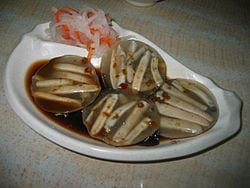Specimen of the Week: Week 138
By Stacy Hackner, on 2 June 2014
 This week’s specimen is another invertebrate. As a bone researcher filling at the front desk, invertebrates don’t usually hold my attention (they lack bones, you see), but I make an exception for this unassuming annelid-like sea creature. This Specimen of the Week is a wet specimen, greyish in color, with what looks like an eye near its mouth, which means it’s a…
This week’s specimen is another invertebrate. As a bone researcher filling at the front desk, invertebrates don’t usually hold my attention (they lack bones, you see), but I make an exception for this unassuming annelid-like sea creature. This Specimen of the Week is a wet specimen, greyish in color, with what looks like an eye near its mouth, which means it’s a…
**PEANUT WORM**
(That ‘eye’ is actually an anus.)
1) There are up to 500 species of peanut worm, or sipunculid, in the phylum Sipuncula. These unsegmented worms live in the ocean worldwide, hiding out in mud, crevices, discarded mollusc shells, holes in corals, and even spaces created by knotted seaweed. (Bonus fact! Did you know the study of fossilized tracks and holes is called ichnology?) One species from French Polynesia even bore into rocks. It’s rather incredible that they can do this as they are rather squishy: they do have a thin outer shell called the cuticle, but one researcher has referred to them as ‘basically fluid-filled bags’. Apparently they can secrete a substance that dissolves limestone and then pick it away with a particularly sharp bit of cuticle.
2) The peanut worm is pretty good at hiding as it feeds in a totally unique way. The mouth is located on the end of a proboscis or ‘introvert’ and often surrounded by small tentacles. The peanut worm can eject the proboscis to eat, making it look like a Dr. Seuss creature, and then retract it inside its body so it remains unseen; in this retracted state, it kind of looks like a peanut from the right angle. Being tannish-brown also helps the illusion, but it’s not fooling anyone in the ocean: its best defence is staying hidden. As detritivores, they’ll eat pretty much anything that happens to float by, so they can really just wait around until they’re hungry enough.

Peanut worm anatomy – note the spiral gut!
Credit: Ron Shimek.
3) Not only do they have introverts, peanut worms also are introverts. They can reproduce sexually or asexually, and seem to spend entire lifetimes in a single burrow. If reproducing asexually, they divide transversely and then regenerate the lost body parts. When reproducing sexually, they squirt gametes into the surrounding water using the introvert, where they mix with those of other nearby worms. Additionally, some species hatch directly into their adult form. This is not quite as strange as boa constrictors giving birth to live young, but still rather unusual. Also, did I mention the anus is on the ‘shoulder’ area? Yup. I assume this is so anything excreted will go out into the ocean rather than into the back of the burrow.
4) Scientists are still arguing where they fit on the phylogenetic tree. They were originally believed to be annelids (more traditional segmented worms), but actually share more in common with molluscs, particularly in early embryological development. Another theory places them within trochozoa, a large group that (oddly enough) also contains annelids. There are few examples of peanut worms in the fossil record, but it’s possible that they are most representative of ancient molluscs. Interestingly, a group of fossils known as hyoliths appear to have conical mollusc-like shells, their intestines are coiled and looped just like those of the peanut worm. Some species of peanut worm still secrete a hard anal shield, which could be the only remnant of the peanut worm’s ancestral shell.
5) Peanut worms are edible and economically useful! In southern China, peanut worm jelly is a delicacy. One adventurous English eater remarks that they taste only of the flavourings added. (I wonder if they are anything like the sea cucumber I was served – not that they are in any way related.) Peanut worms, according to Sea Angler magazine, are particularly good for use as bait, but have not been extensively used thus far as they are rather difficult to find and capture (see point 2 about hiding). They sometimes make their way into home aquaria, managing to hide out in the rock or coral burrows collected for sale until an unsuspecting fish enthusiast notices an extra mouth to feed in their aquarium. Really: they will only notice the mouth.
Stacy Hackner is a Research Engager with UCL Museums
One Response to “Specimen of the Week: Week 138”
- 1
 Close
Close




[…] Grant Museum specimen goodness! In order to celebrate this sort of milestone, and following on from Stacy’s worm theme, this week’s specimen is (probably) the oldest specimen in the Grant Museum. With a […]